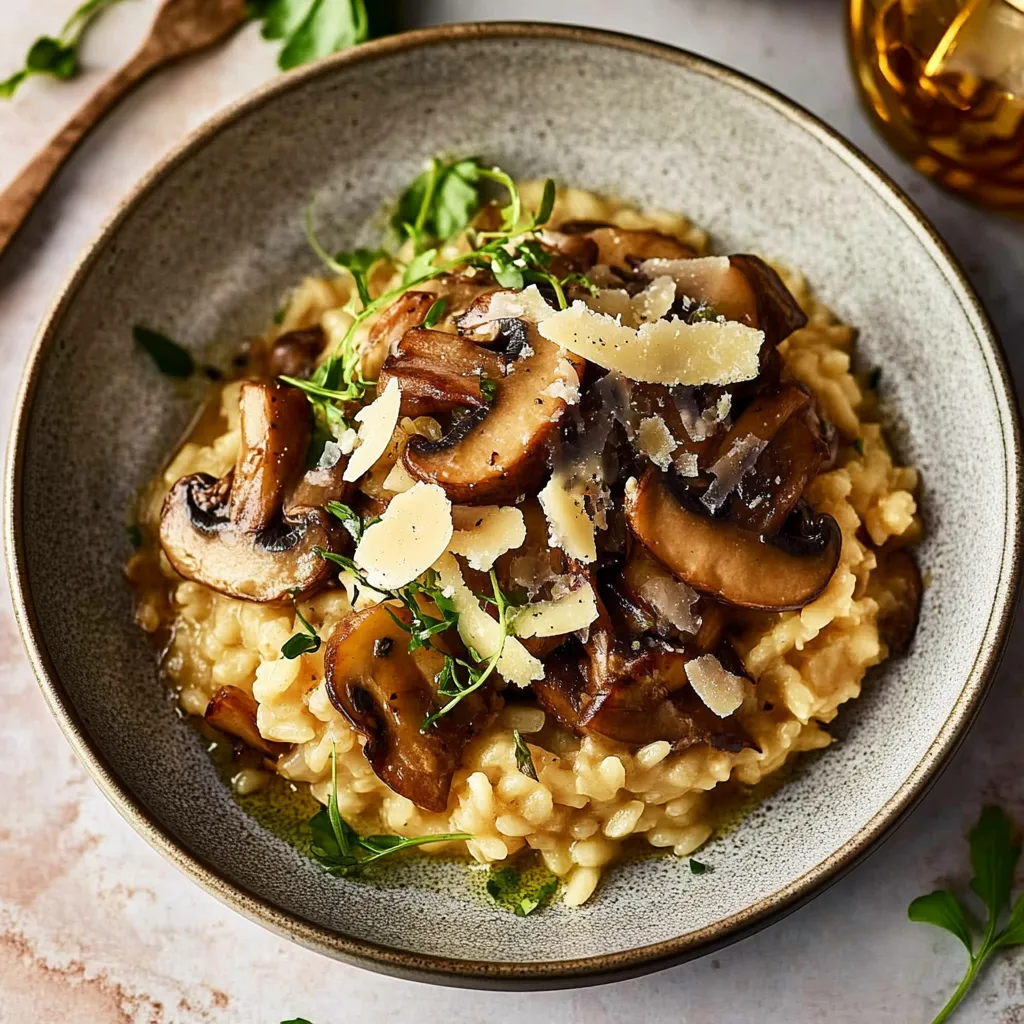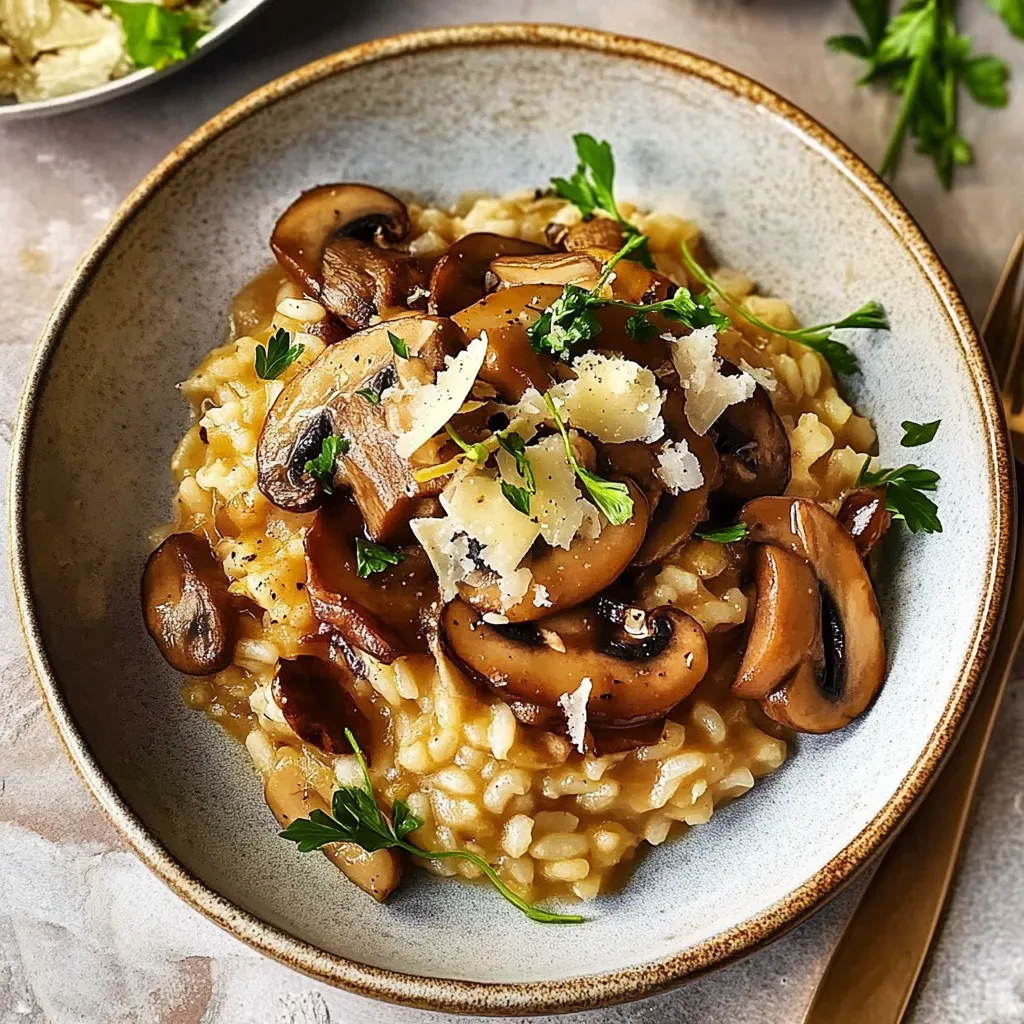 Pin it
Pin it
This creamy mushroom risotto has been my go-to dinner party showstopper for years. The earthy mushroom flavor pairs perfectly with the velvety texture of properly cooked arborio rice, creating a restaurant-worthy dish right in your home kitchen.
I first made this risotto on a rainy Sunday evening when I craved comfort food but wanted something more sophisticated than pasta. After one bite, my family declared it better than our favorite Italian restaurant's version, and it's been on regular rotation ever since.
Ingredients
- Extra virgin olive oil: Provides the perfect foundation for developing flavor without overpowering the delicate mushrooms
- Mixed mushrooms: Use a combination of cremini, shiitake, and oyster for the most complex flavor profile
- Sea salt: Enhances all the flavors in the dish, especially crucial for properly seasoning the mushrooms
- Yellow onion: Creates the aromatic base, look for firm onions with tight, dry skin
- Garlic cloves: Adds necessary punch, select heads with tight skin and no sprouting
- Fresh thyme leaves: Brings an earthy, slightly floral note that complements mushrooms perfectly
- Arborio rice: Special short-grain rice with high starch content that creates the signature creamy texture
- Dry white wine: Adds acidity and depth, choose something you'd enjoy drinking like Sauvignon Blanc or Pinot Grigio
- Vegetable broth: Forms the backbone of flavor, use homemade for best results or a high-quality low-sodium store bought
- Pecorino or Parmesan cheese: Provides the salty umami finish, always buy a block and grate it yourself for best melting
- Fresh parsley: Brightens the final dish with color and fresh flavor
Step-by-Step Instructions
- Sauté the Mushrooms:
- Heat olive oil until shimmering but not smoking. Add mushrooms with salt and pepper, spreading them in an even layer. Resist the urge to stir constantly as this prevents proper browning. The mushrooms will release moisture initially, then begin to caramelize once that moisture evaporates. This creates concentrated umami flavor that makes the risotto exceptional.
- Build the Flavor Base:
- Wipe the pan clean to prevent any burnt bits from affecting the final dish. Gently cook the onions until translucent but not browned, about 5 to 8 minutes. This slow cooking develops sweetness without bitterness. Add garlic and thyme just briefly to release their aromatics without burning.
- Toast the Rice:
- Add arborio rice to the aromatic base and stir continuously for a full minute. This crucial step coats each grain with oil and begins toasting the exterior, which helps maintain the rice's structure during cooking while allowing it to release starch slowly.
- Deglaze with Wine:
- Pour wine into the hot pan, stirring vigorously to scrape up any flavorful bits from the bottom. The alcohol will evaporate, leaving behind aromatic compounds that enhance the overall depth of flavor. Allow the wine to reduce until the pan is almost dry.
- Add Broth Gradually:
- Begin adding warm broth in small increments, waiting until each addition is nearly absorbed before adding more. This slow method allows the rice to release its starch gradually, creating the signature creamy texture. Keep the mixture at a gentle simmer throughout cooking, never boiling rapidly.
- Incorporate Mushrooms and Cheese:
- When rice reaches the perfect texture slightly al dente with a creamy surrounding sauce fold in most of the sautéed mushrooms. This distributes their flavor throughout the dish while reserving some for an attractive garnish. Finally, stir in freshly grated cheese off the heat to create a silky finish without clumping.
 Pin it
Pin it
The first time I served this mushroom risotto at a dinner party, the table fell completely silent for a full minute as everyone took their first bites. That moment confirmed for me that simple ingredients prepared with care can create truly memorable experiences. I particularly love using a mix of wild mushrooms when they're in season at my local farmers market.
The Secret to Perfectly Cooked Rice
Achieving the ideal risotto texture depends on several factors. First, never rinse arborio rice before cooking as you need that surface starch. Second, maintain a gentle simmer throughout cooking never letting it boil vigorously or cool down completely. Finally, trust your instincts taste the rice frequently toward the end of cooking. The perfect texture has a slight resistance when bitten a quality Italians call al dente but the overall dish should be creamy and flowing.
Mushroom Selection Guide
While any mushrooms will work in this recipe, different varieties offer unique contributions. Button mushrooms provide a mild foundation, while cremini (baby portobellos) add more robust flavor. For luxury versions, incorporate wild mushrooms like chanterelles, porcini, or morels. Dried mushrooms can also be reconstituted in hot water, with that flavorful soaking liquid incorporated into your broth for intensified mushroom essence. For everyday cooking, a mix of cremini and shiitake creates wonderful complexity without requiring specialty ingredients.
Making Ahead and Storing
Contrary to popular belief, risotto can be partially made ahead. Cook until the rice is about halfway done, then spread on a baking sheet to cool quickly. Refrigerate for up to a day, then resume cooking with hot broth when ready to serve. Leftover fully cooked risotto keeps well refrigerated for 3 days. When reheating, add a splash of broth or water to restore creaminess. The texture will never be quite as perfect as freshly made, but the flavor often deepens overnight.
 Pin it
Pin it
This mushroom risotto proves that with care and attention, simple ingredients can create a truly unforgettable dining experience.
Frequently Asked Questions
- → Can I use different types of mushrooms?
Absolutely! While the recipe calls for mixed mushrooms, you can use any combination of varieties such as cremini, shiitake, portobello, oyster, or chanterelle. Each type brings its own unique flavor profile, so experimenting with different combinations can create wonderful variations.
- → Is it necessary to warm the broth before adding it?
Yes, warming the broth is important. Adding cold broth to the hot rice would shock the cooking process and result in uneven cooking. Warm broth maintains the steady cooking temperature needed for properly developing the creamy starch that makes risotto special.
- → Can I make this dish vegan?
Yes, this dish can easily be made vegan by omitting the cheese or substituting it with nutritional yeast or a vegan parmesan alternative. The risotto will still be creamy and flavorful from the slow-cooking method and rich mushroom flavor.
- → Why is constant stirring important when making risotto?
Constant stirring serves two important purposes: it prevents the rice from sticking to the bottom of the pan and burning, and it helps release the starches from the arborio rice, creating that signature creamy texture that defines a good risotto.
- → Can I prepare mushroom risotto in advance?
While risotto is best served immediately after cooking, you can prepare it slightly in advance. Cook until just before it's completely done, then spread it on a baking sheet to cool. When ready to serve, return it to the pan, add a bit more warm broth, and finish cooking while stirring. Add the cheese just before serving.
- → What can I substitute for white wine?
If you prefer not to use wine, you can substitute with additional vegetable broth plus 1-2 tablespoons of lemon juice to add the acidity that wine would provide. This maintains the bright flavor balance of the dish.
